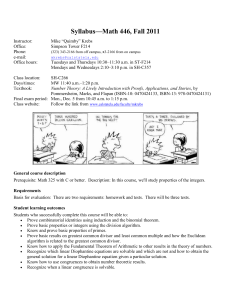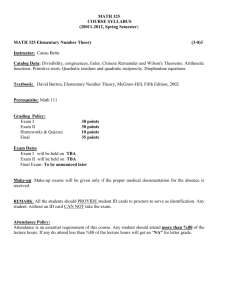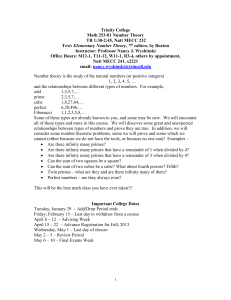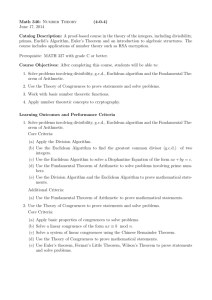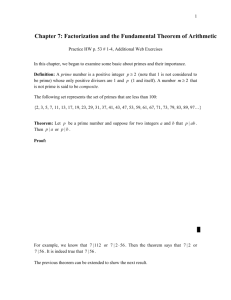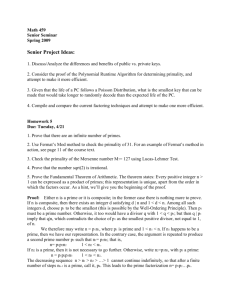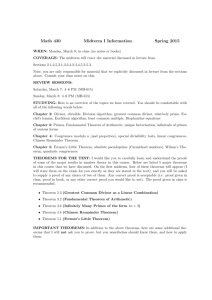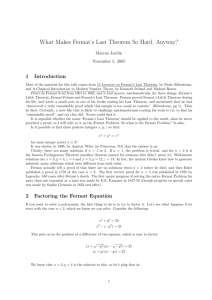MTH 3214
advertisement
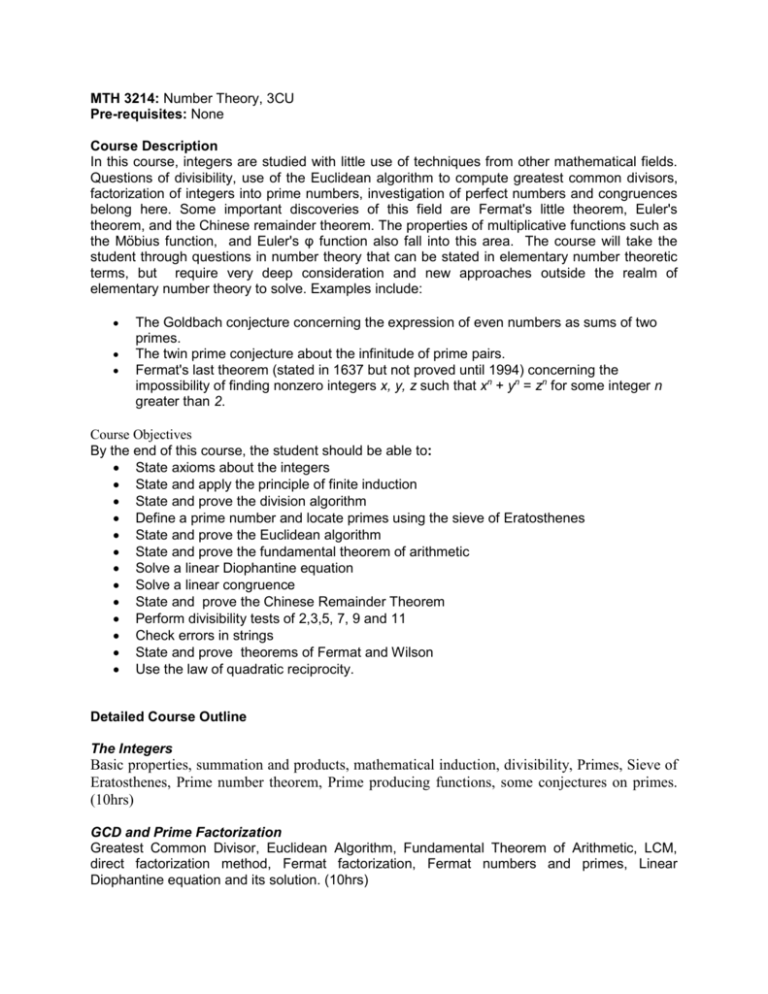
MTH 3214: Number Theory, 3CU Pre-requisites: None Course Description In this course, integers are studied with little use of techniques from other mathematical fields. Questions of divisibility, use of the Euclidean algorithm to compute greatest common divisors, factorization of integers into prime numbers, investigation of perfect numbers and congruences belong here. Some important discoveries of this field are Fermat's little theorem, Euler's theorem, and the Chinese remainder theorem. The properties of multiplicative functions such as the Möbius function, and Euler's φ function also fall into this area. The course will take the student through questions in number theory that can be stated in elementary number theoretic terms, but require very deep consideration and new approaches outside the realm of elementary number theory to solve. Examples include: The Goldbach conjecture concerning the expression of even numbers as sums of two primes. The twin prime conjecture about the infinitude of prime pairs. Fermat's last theorem (stated in 1637 but not proved until 1994) concerning the impossibility of finding nonzero integers x, y, z such that xn + yn = zn for some integer n greater than 2. Course Objectives By the end of this course, the student should be able to: State axioms about the integers State and apply the principle of finite induction State and prove the division algorithm Define a prime number and locate primes using the sieve of Eratosthenes State and prove the Euclidean algorithm State and prove the fundamental theorem of arithmetic Solve a linear Diophantine equation Solve a linear congruence State and prove the Chinese Remainder Theorem Perform divisibility tests of 2,3,5, 7, 9 and 11 Check errors in strings State and prove theorems of Fermat and Wilson Use the law of quadratic reciprocity. Detailed Course Outline The Integers Basic properties, summation and products, mathematical induction, divisibility, Primes, Sieve of Eratosthenes, Prime number theorem, Prime producing functions, some conjectures on primes. (10hrs) GCD and Prime Factorization Greatest Common Divisor, Euclidean Algorithm, Fundamental Theorem of Arithmetic, LCM, direct factorization method, Fermat factorization, Fermat numbers and primes, Linear Diophantine equation and its solution. (10hrs) Theory of Congruences Introduction to congruences, properties, residues modulo m, Algebra of Congruences, Linear congruences, special congruences, The Chinese Remainder theorem, Systems of Linear congruences, Divisibility tests, check digits, Theorems of Wilson, Euler and Fermat. (9hrs) Multiplicative Functions The Euler Phi-function, the sum and number of divisors, Perfect numbers and Mersenne primes. (6hrs) Applications of Number Theory Character or Monographic ciphers. (4hrs) Quadratic Residues Legendre symbol, Quadratic Reciprocity, Jacobi’s symbol, The order of an integer, Primitive roots. (6hrs) Reading List The reading list will include but is not limited to the following texts. Burton, D.M (1976). Elementary Number Theory. Allyn and Bacon. Kasozi, J. and Mangheni, P.J. Number Theory. Department of Distance Education, IACE, Makerere University. (in print) Hardy, G.H and Wright, E.M (1979). An Introduction to the Theory of Numbers. 5th Edition, Oxford University Press. Learning Outcome State axioms about the integers State and apply the principle of finite induction State and prove the division algorithm Define a prime number and locate primes using the sieve of Eratosthenes State and prove the Euclidean algorithm State and prove the fundamental theorem of arithmetic Solve a linear Diophantine equation Solve a linear congruence State and prove the Chinese Remainder Theorem Perform divisibility tests of 2,3,5, 7, 9 and 11 Check errors in strings State and prove theorems of Fermat and Wilson Use the law of quadratic reciprocity.
